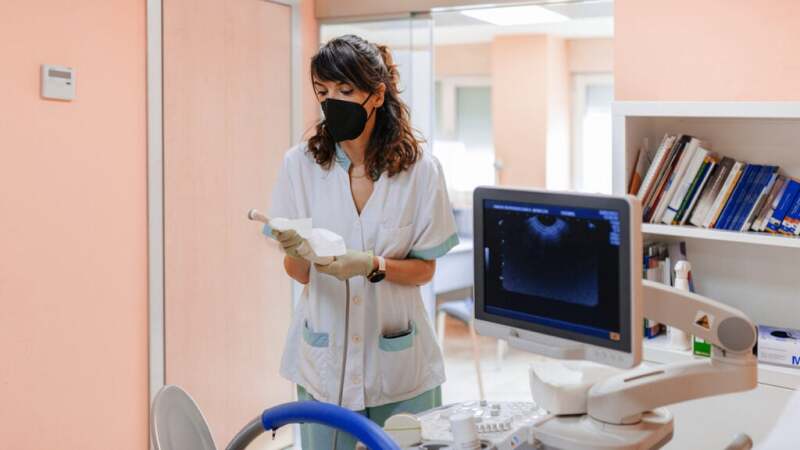This article discusses the purpose of a kidney ultrasound, how to prepare for an ultrasound, what happens during an ultrasound, and possible risks.
What is the purpose of a kidney ultrasound?

A kidney ultrasound can help doctors assess the kidneys’ structures and surrounding tissues to determine why you may be experiencing pain or a change in kidney function.
One of the most common reasons for a kidney ultrasound is when a person has flank pain. You can feel flank pain on either side of your lower back, just below your rib cage and above your waist.
A kidney ultrasound is also crucial when
Other purposes of a kidney ultrasound include looking for:
- kidney infection
- tumors or cysts
- blockages
- congenital abnormalities
- blood flow in and around the kidneys
- fluid buildup in the kidneys
Doctors can also use an ultrasound to help with several medical procedures. These may include:
- draining a cyst or abscess
- guiding a needle to take a biopsy, or small tissue sample, of the kidney
- placing a drainage tube, or nephrostomy, in your kidneys

When might I need a kidney ultrasound?
Your doctor may order a kidney ultrasound if you have symptoms related to your kidneys, such as:
- flank pain
- blood in your urine
- frequent need to urinate
- difficulty urinating
- decreased urination
- swelling in your legs, ankles, or feet
- high blood pressure
Some people
Learn more about the signs and symptoms of kidney issues.
People who undergo kidney transplants typically have a kidney ultrasound within
How do I prepare for a kidney ultrasound?
In general, preparing for a kidney ultrasound is simple. Your doctor may give you some general guidelines to follow, including:
- Drink plenty of water before the procedure.
- Have a full bladder during the procedure.
- Wear comfortable, loose clothing.
- Tell your doctor about any medications you take.
Typically, you do not have to fast before a kidney ultrasound, but your doctor may have other instructions. Be sure to closely follow their directions and ask questions if you need help understanding them.
What happens during a kidney ultrasound?
Several locations may offer kidney ultrasounds, such as hospitals, imaging centers, or clinics. Each location may have its own protocol for kidney ultrasounds, but here is a general picture of what your experience may be like.
Your kidney ultrasound will occur in a quiet and possibly dimly lit room. The ultrasound technician will ask you to lie down on a table and expose your abdominal area.
The technician will apply a clear gel to your skin, which can help improve the ultrasound images. They will then use a transducer, a small hand-held device, to run along your skin in the areas they need to collect images.
This device uses high frequency sound waves to pass through your body and bounce off your organs, creating echoes. These readings go to a computer, where they turn into images.
The technician may ask you to move into certain positions or hold your breath to get clearer images.
You should not feel pain during the procedure, but you may feel some pressure. When the test is complete, the technician will clean the gel off your skin and let you know when you can use the restroom.
What can I expect after a kidney ultrasound?
After your ultrasound, you should be able to resume your usual activities right away. However, your care team will let you know if there are any limitations.
A radiologist will review your images and send the results to your doctor. Follow up with your doctor to determine when they will review the report with you.
Learn more about what to expect after an abdominal ultrasound.
Are there any risks with a kidney ultrasound?
A kidney ultrasound is usually a safe and noninvasive imaging study with
The sound waves should not be harmful to your body, and the gel used on your skin is usually safe and should not cause any harm or side effects.
Learn more about the limitations of ultrasound scans.
When should I see a doctor?
Contact your doctor if you have symptoms of kidney health conditions, such as:
- lower back or flank pain
- blood in your urine
- swelling in your legs, ankles, or feet
- a sensation of burning when you urinate
- difficulty urinating
- frequent urination or urinating more at night
- high blood pressure
Because kidney health conditions may not always cause symptoms, be sure to contact your doctor for regular checkups and lab testing to check your kidneys’ health.
Other frequently asked questions
Carissa Stephens, R.N., CCRN, C.P.N., reviewed the answers to these common questions about kidney ultrasounds.
Can kidney damage be seen on an ultrasound?
Yes, a kidney ultrasound can check the sizes, shapes, and internal structures of your kidneys. Your doctor may order a CT scan if further images are necessary.
Why would a doctor order a kidney scan?
Your doctor may order a kidney scan to evaluate the kidneys and surrounding structures for abnormalities or signs of conditions such as kidney stones, tumors, or infection.
Summary
A kidney ultrasound is a noninvasive imaging study that uses high frequency sound waves to create images of the kidneys. The test can detect kidney stones, tumors, infections, and congenital abnormalities.
A kidney ultrasound is generally safe and has little to no complications. It is typically painless and usually requires little preparation.
It may take several days for your doctor to get the results of your kidney ultrasound. Follow up with them to get your results. Also, let your doctor know if any symptoms persist or worsen.


















